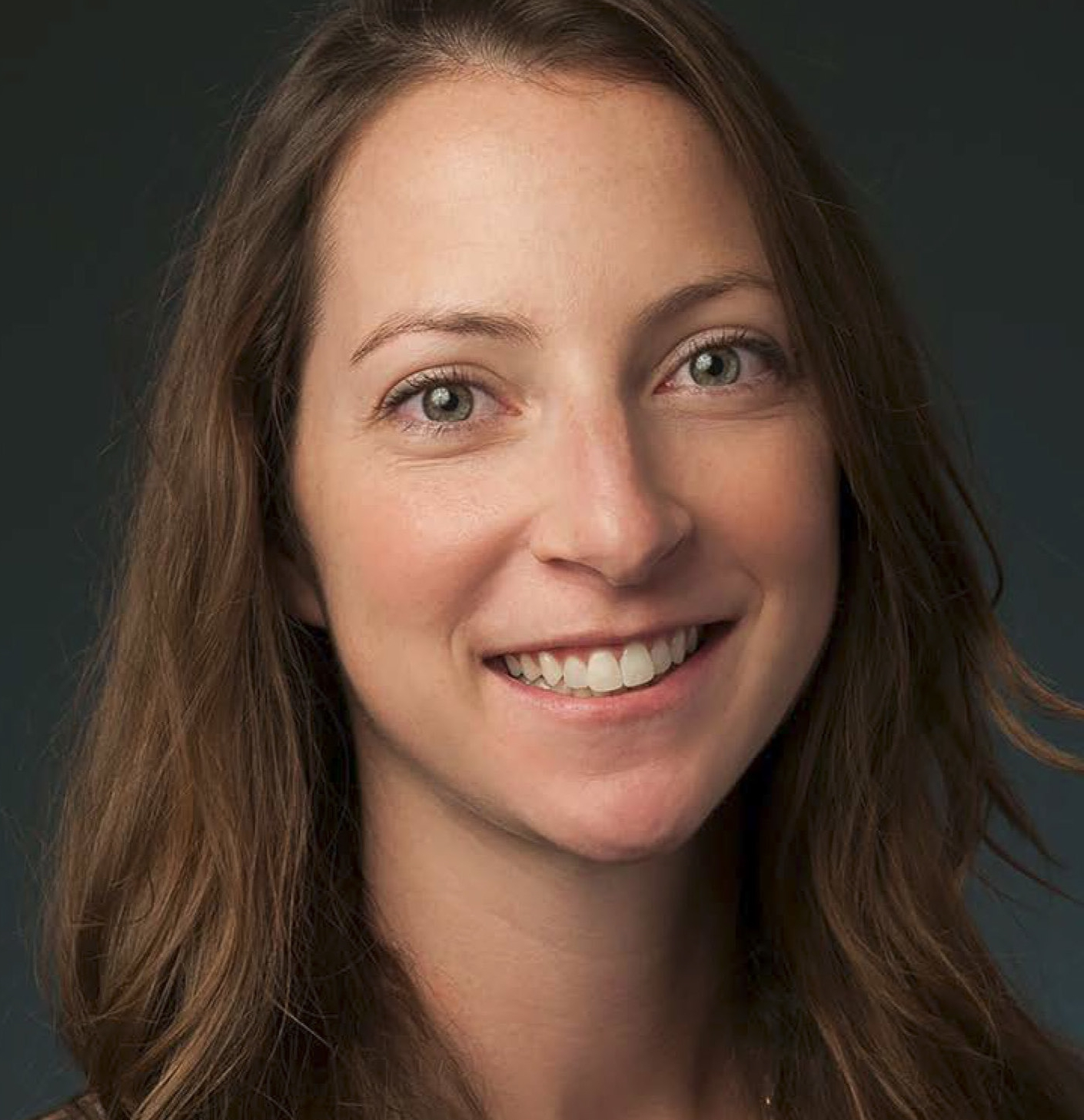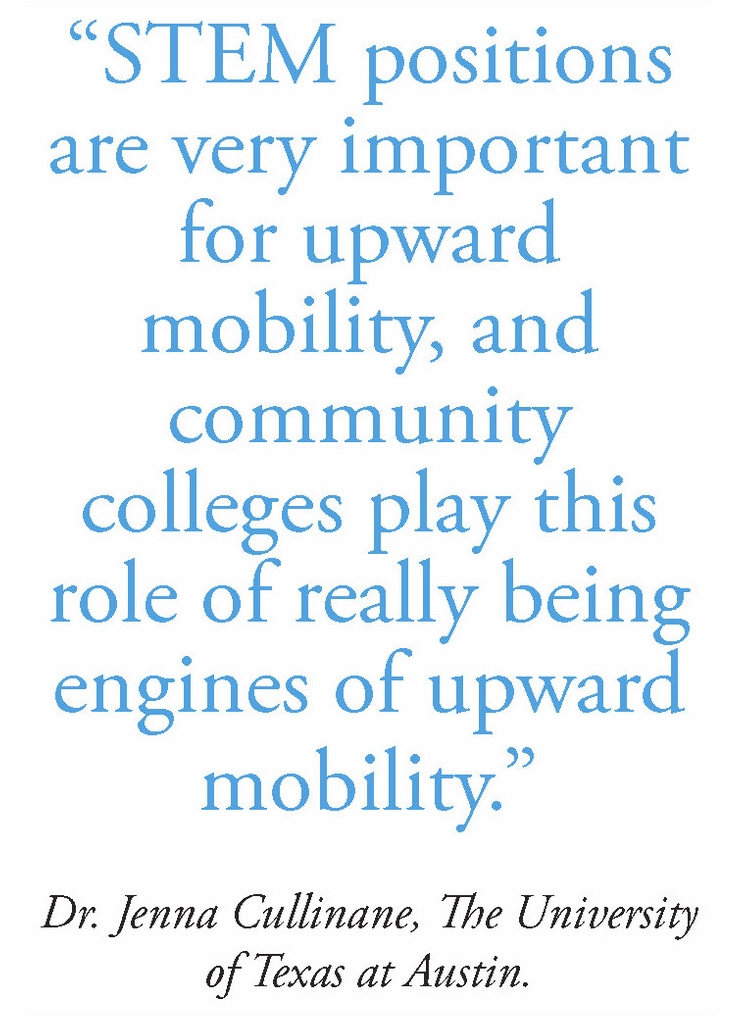When it comes to educating low-income students and students of color, community colleges do the heavy lifting. They educate students for robust jobs that require sub-baccalaureate credentials in middle level STEM (Sciences Technology Engineering and Math) positions and promise premium wages. They open educational opportunities and reduce class and racial imbalances in educational attainment, career advancement and wealth accumulation.
When it comes to educating low-income students and students of color, community colleges do the heavy lifting. They educate students for robust jobs that require sub-baccalaureate credentials in middle level STEM (Sciences Technology Engineering and Math) positions and promise premium wages. They open educational opportunities and reduce class and racial imbalances in educational attainment, career advancement and wealth accumulation.
“STEM positions are very important for upward mobility, and community colleges play this role of really being engines of upward mobility. STEM fields in particular are associated with having livable wages and above living wage level positions,” said Jenna Cullinane, Ph.D., strategic policy lead for higher education initiatives at The Charles A. Dana Center, The University of Texas at Austin.
[caption id="" align="alignnone" width="1410.0"] Jenna Cullinane, Ph.D.[/caption]
Jenna Cullinane, Ph.D.[/caption]
To ensure that community college and four-year college students who are interested in STEM jobs enter and complete the math courses required to compete in these fields, Jobs for the Future, The Charles A. Dana Center at The University of Texas at Austin and Achieving the Dream released a call to action. The document was coauthored by Cullinane. It’s called “A Call to Action to Improve Math Placement Policies and Processes: Six Policy Recommendations to Increase STEM Student Aspirations and Success While Decreasing Racial and Income Gaps,” and it encourages states and colleges to revise their math placement policies, processes and supports.
“We think it’s really important that all students have access to (STEM jobs), and many students, especially low income and minority students, don’t have the math skills or the background from their K-12 experience to be really competitive and to perform well in some of these STEM programs,” Cullinane said.
Redesigning Math Pathways
The nation cannot allow placement policies, processes and instruments to undermine promising efforts to increase student success in mathematics and increase attainment of STEM credentials, Cullinane wrote in the report. She contends that efforts to redesign math pathways can improve the teaching and learning experiences of students who need college algebra—many of whom are STEM students—and help those students persist toward and maintain STEM aspirations.
The biggest barrier minority students face persisting in STEM programs is math preparation. “If students are not successful in mathematics early in their programs, they often leave the STEM fields,” Cullinane said. Some leave college altogether.
Keeping students interested in STEM has become a priority at many colleges. The more progressive ones have created differentiated developmental and gateway math pathways targeting the math needs of particular academic programs while improving teaching, learning and support in math. Students who need algebra remediation, for example, can enroll in redesigned math classes while those who do not take an alternative pathway that aligns with their program.
Redesigning math pathways, however, is not enough. If placement policies, processes and supports do not keep pace with the change, school place students by using methods that do not align with the content of or that do not effectively predict or support success in differentiated math pathways. When this occurs, the differentiated pathways actually close doors to STEM opportunities.
To ensure those doors remain open, schools must modify their placement processes and consider students’ goals, majors, interests, time and capability within that process. “The placement process should be a much more comprehensive, in-take supportive process,” Cullinane said.
The Report’s Recommendations
Cullinane and her co-author Lara K. Couturier (who leads research and publications for Jobs for the Future’s Postsecondary State Policy work) designed their six recommendations as a roadmap for colleges. To begin with, they encourage schools to begin their placement support process early to ensure freshmen are ready for college-level math.
Successful programs assess high school students early to determine their readiness and provide them with information about how much time and money they’ll need to complete a degree. “It’s good to give the students that information early,” Cullinane said.
High schools students interested in STEM programs that require algebra should begin work to meet that requirement early. Colleges should provide high school counselors who can discuss students’ career interests. High schools should allow students to take college placement exams early and provide intensive math courses the summer before they enroll in college.

Research suggests that existing placement instruments alone are not good predictors of student success in college. Other measures, like high school GPA, work well if not better to determine student placement into developmental education. Some states and colleges are shifting placement practices to include cognitive and non-cognitive measures, high school performance, holistic advising and acceleration and co-requisite placement. Cullinane recommends that all colleges follow suit.
“The Compass test has been discontinued and there have been a variety of studies that have basically undermined the traditional assessments that have been used primarily in community colleges,” Cullinane said. “High school grades are actually a better indicator of success in college level work and could be used in combination with other assessment information.”
No assessment fits the needs of all students and educators. Existing assessments often do not reflect differentiated content and especially not content that would help place a student in a statistics or quantitative reasoning pathway. Cullinane recommends that colleges require test makers to align placement tests with differentiated math pathways and improve their predictive value, even as states move toward using multiple measures of placement.
She encourages test makers, mathematicians and representatives of other disciplines to collaborate. “Tests right now focus on algebraic skills students will need if they are going on to calculus. But we know that two thirds of students, nationally and in Texas, are enrolled in programs that do not require calculus. So a great majority of programs would be better served by a statistics or quantitative reasoning type course. Current assessments don’t cover any of that material,” Cullinane said.
Orientation, advising and assessment services are key supports for accurate and equitable placements and help students make good program choices, determine their developmental and college-level math needs and select courses within their intended programs. Students’ goals and needs should drive this process, Cullinane wrote. As colleges offer differentiated math pathways, she recommends that schools keep academic doors open for all students and eliminate equity implications for students who arrive unprepared. As schools revise their placement processes she wants them to keep an eye on student intentions.
During the placement process, schools must prioritize student academic and career goals, making every effort to keep STEM-aspiring students on STEM pathways. Schools should create cohorts of students grouped by program interest, advise students accordingly, provide supplemental help and support differentiated math pathways placement no matter their readiness.
Finally, Cullinane and Couturier recommend that schools create a bridging mechanism from non-algebra pathways to algebra pathways. Even with the most robust placement processes and policies, some students switch programs, affecting the required math courses. “Sometimes people raise their aspirations. We want to make sure students (can do this), without having to repeat coursework and spend a lot more time and money moving to a program that would be more STEM intensive,” Cullinane said.
Cullinane hopes her Call to Action kicks off an important national conversation followed by state and college changes to assessment and placement policies, processes and supports. “We put out this report as a call to action to say that this is an area that policy makers both at the institution and state level need to really be thinking about. We are seeing more and more momentum and similar calls coming from different entities,” Cullinane said.